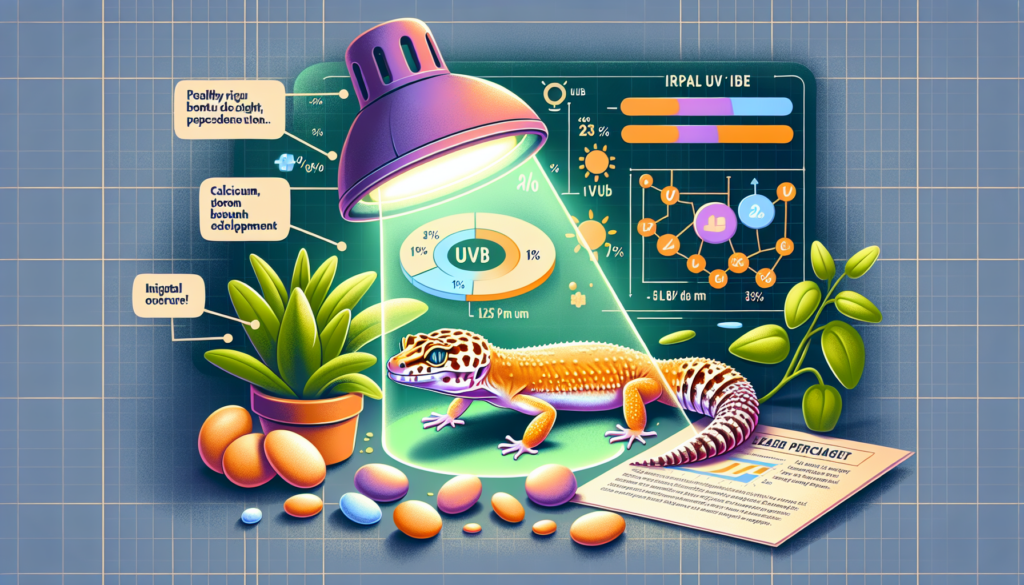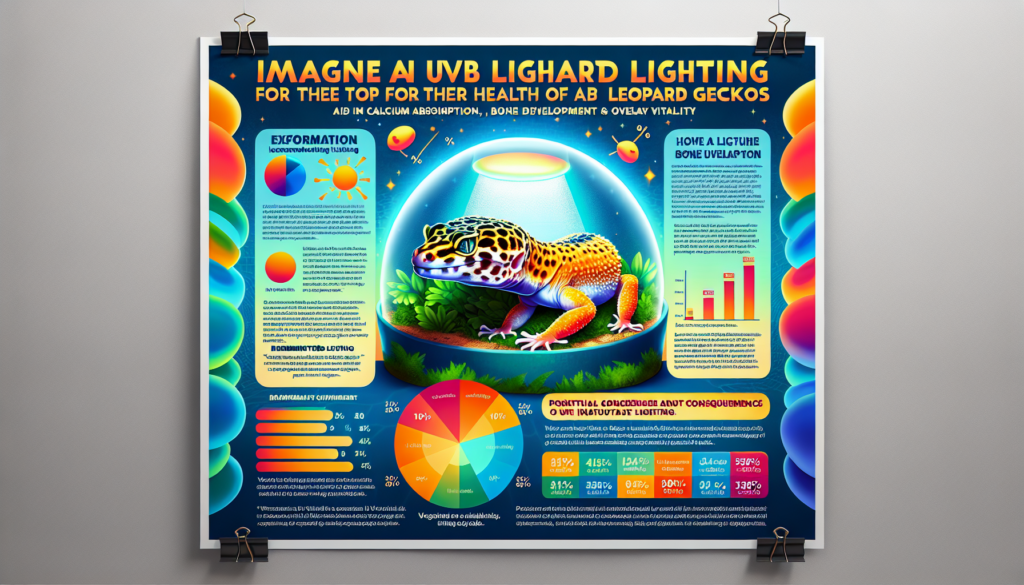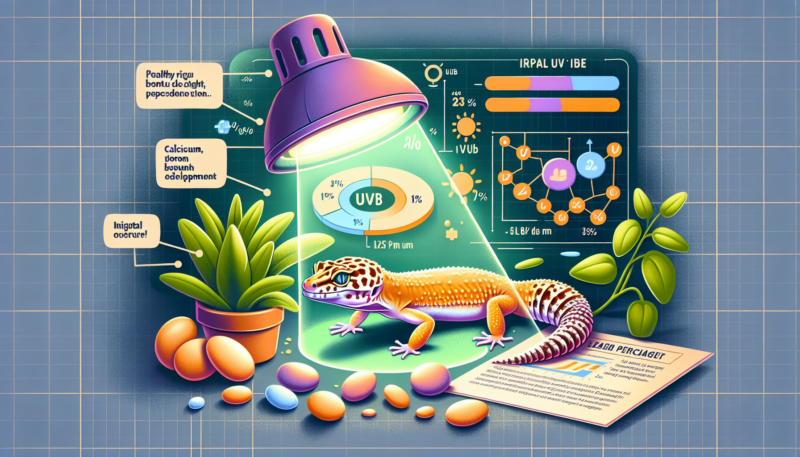Did you know that the percentage of UVB light required for a leopard gecko’s thriving health is a topic of great interest among reptile enthusiasts? Providing your leopard gecko with the correct amount of UVB light is crucial for its overall well-being. In this article, we will explore the importance of UVB light, discuss the ideal percentage needed for leopard geckos, and offer tips on how to ensure your pet’s UVB needs are met. So, let’s shed some light on the fascinating world of leopard gecko UVB percentage!
Leopard Gecko UVB Percentage
Welcome to this comprehensive article on the UVB percentage requirements for leopard geckos. In this article, we will explore the importance of UVB for leopard geckos, understanding their natural environment, the role of UVB in their overall health, and the various sources of UVB available for these fascinating reptiles. We will also address common misconceptions surrounding leopard geckos and UVB, factors to consider when choosing the right UVB percentage, recommended UVB percentages for different life stages, methods of providing UVB, and the monitoring and maintenance of UVB for leopard geckos. So, let’s get started!
Understanding the Importance of UVB for Leopard Geckos
Leopard geckos, like many other reptiles, have unique UVB requirements due to their natural habitat and physiology. In the wild, leopard geckos inhabit the arid regions of Afghanistan, Pakistan, and India, where they are exposed to natural sunlight. UVB radiation plays a crucial role in the health and well-being of these reptiles.
The Natural Environment of Leopard Geckos
In their natural environment, leopard geckos bask under the sun’s UVB rays, allowing their skin to synthesize vitamin D3. This synthesized vitamin D3 is then crucial for proper calcium uptake and metabolism, preventing the onset of metabolic bone disease (MBD). The balance between UVB exposure, calcium intake, and vitamin D3 synthesis is essential for the overall health of leopard geckos.

The Role of UVB in Reptile Health
UVB radiation is necessary for reptiles to synthesize vitamin D3, which is vital for calcium metabolism and bone health. Without adequate UVB exposure, reptiles can develop various health issues, including metabolic bone disease, decreased immune function, poor growth, and even reproductive problems. Providing leopard geckos with the appropriate UVB percentage is crucial for maintaining their overall health and well-being.
Effects of UVB Deficiency in Leopard Geckos
A lack of UVB radiation can have severe consequences for leopard geckos. UVB deficiency can lead to metabolic bone disease, a condition in which their bones become weak, fragile, and deformed. Signs of metabolic bone disease include bowed limbs, soft jaws, difficulty shedding, and decreased appetite. It is crucial to ensure that leopard geckos receive sufficient UVB exposure to prevent these debilitating health issues.

Sources of UVB for Leopard Geckos
Now that we understand the importance of UVB for leopard geckos, it is essential to consider the different sources of UVB available for these reptiles.
Natural Sunlight
In their natural habitat, leopard geckos receive UVB exposure from the sun. Natural sunlight is the most ideal and natural source of UVB radiation for leopard geckos. However, when kept as pets, replicating natural sunlight can be challenging, especially in areas with limited access to direct sunlight.
Artificial UVB Lighting
To meet the UVB requirements of leopard geckos, artificial UVB lighting is a popular and effective solution. These artificial lights are specially designed to emit UVB radiation similar to natural sunlight, allowing leopard geckos to receive the UVB they need for proper health and development.
Common Misconceptions about Leopard Geckos and UVB
There are a few common misconceptions surrounding leopard geckos and their need for UVB exposure. One misconception is that leopard geckos are entirely nocturnal and do not need UVB radiation. While leopard geckos are primarily nocturnal, they do benefit from UVB exposure and require it to maintain their overall health. UVB helps the geckos in synthesizing vitamin D3 and preventing various health issues.
Factors to Consider When Choosing the Right UVB Percentage for Leopard Geckos
Several factors should be taken into account when selecting the appropriate UVB percentage for leopard geckos. These factors include the age and life stage of the gecko, UVB output and percentage, and the distance from the UVB source.
Age and Life Stage of the Leopard Gecko
The UVB requirements of leopard geckos can vary depending on their age and life stage. Juvenile leopard geckos, in their rapid growth phase, may require a higher UVB percentage compared to adult geckos, who may need a lower percentage to maintain their health.
UVB Output and Percentage
Different UVB bulbs have varying output percentages, so it is important to select a bulb that provides the right amount of UVB for your leopard gecko’s needs. It is recommended to choose a UVB bulb specifically designed for reptiles and to follow the manufacturer’s guidelines for proper usage.
Distance from UVB Source
The distance between the leopard gecko and the UVB source can affect the amount of UVB radiation they receive. It is essential to ensure that the gecko can bask within the recommended distance specified by the UVB bulb manufacturer to receive optimal UVB exposure.
Recommended UVB Percentage for Juvenile Leopard Geckos
Juvenile leopard geckos have higher UVB requirements due to their rapid growth phase. It is recommended to provide them with UVB lighting that ranges between 5-8% depending on their specific needs. This higher UVB percentage helps support their bone development and overall health during this critical stage.
Recommended UVB Percentage for Adult Leopard Geckos
As leopard geckos reach adulthood, their UVB requirements decrease. Adult leopard geckos may require UVB lighting with a lower percentage, typically around 2-5%. This reduced UVB requirement helps maintain their health and well-being, ensuring they receive the necessary vitamin D3 synthesis without any risk of overexposure.
Methods of Providing UVB for Leopard Geckos
There are several methods available for providing UVB to leopard geckos, each with its advantages and considerations. Some common methods include mercury vapor bulbs, compact fluorescent bulbs, and T5 high output linear fluorescent tubes.
Mercury Vapor Bulbs
Mercury vapor bulbs are a popular option as they provide both UVB and heat in a single bulb. These bulbs are energy-efficient and emit both UVA and UVB radiation, simulating the natural sunlight that leopard geckos require.
Compact Fluorescent Bulbs
Compact fluorescent bulbs are another option for providing UVB to leopard geckos. They are cost-effective and emit a reasonable amount of UVB radiation. However, they require specific fixtures and may need to be replaced more frequently compared to other UVB lighting options.
T5 High Output Linear Fluorescent Tubes
T5 high output linear fluorescent tubes are another reliable option for providing UVB to leopard geckos. These tubes emit more UVB radiation than compact fluorescent bulbs, ensuring that geckos receive an optimal dosage of UVB. However, they may require a larger fixture and additional setup.
UVB Monitoring and Maintenance for Leopard Geckos
Monitoring UVB output and maintaining the UVB lighting setup is crucial to ensure that leopard geckos receive optimal UVB exposure. Regularly monitoring the output of the UVB bulb using a UVB meter can help ensure that it is providing the recommended UVB percentage. Additionally, UVB bulbs should be replaced according to the manufacturer’s instructions to guarantee that they are emitting the necessary UVB radiation. It is also important to regularly clean the UVB fixtures to prevent any potential blockage or hindrance to the UVB radiation.
In conclusion, providing the right UVB percentage for leopard geckos is essential for their overall health and well-being. Understanding the role of UVB in leopard gecko health, the various sources of UVB available, and the factors to consider when choosing the right UVB percentage can help ensure these fascinating reptiles thrive in captivity. By implementing the recommended UVB percentages for different life stages and using appropriate methods of providing UVB, you can support the optimum growth and development of your pet leopard geckos. Remember to monitor and maintain the UVB setup regularly to guarantee that your geckos receive the necessary UVB radiation for a long and healthy life.
